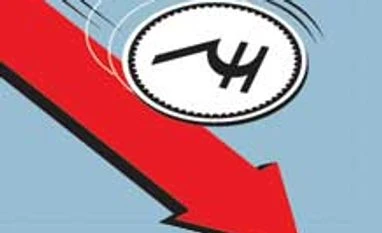Experts see capital flows continuing in India due to higher growth, lower inflation and control over the fiscal and current account deficit (CAD).
On Thursday, the rupee ended at 61.45 to the dollar as compared to the previous close of 61.36. This was sparked by concern on slower fund flows to emerging markets as the US Federal Reserve (Fed) moves closer to raising interest rates after putting an end to its bond-buying programme. During intra-day trade, the rupee weakened to 61.55, its weakest level since October 17. It rupee had opened at 61.52.
Most global currencies had recorded a fall against the dollar on Thursday. The rupiah (Indonesia), peso (Philippines), won (South Korea) and ringgit (Malaysia), as well as the euro, recorded a higher fall compared with the previous close.
“The rupee might continue to trade at 61-62. This might be the range till end-December. There is no sense of panic in the market,” said Anindya Banerjee, a currency analyst at Kotak Securities.
In May 2013, Ben Bernanke, then chairman of the Fed, had hinted at tapering the bond buying, due to which the rupee had weakened significantly. On August 28, 2013, it had touched an all-time low of 68.85 during intra-day trade. Yet, when the actual tapering began, the impact was not much. Similarly, the Street believes when the actual rate rises happen, the impact on the rupee might be limited.
“If capital flows continues to happen in Indian equities, then even interest rate rises in the US will not impact much. What is required for India is to set its house in order, go for aggressive reforms, see that macro factors continue to be very stable,” said Ashutosh Khajuria, president (treasury), Federal Bank.
The central bank is in the process of building stronger foreign exchange reserves, which would help to curtail sharp volatility in the rupee.
Forex reserves rose by $945.6 million for the week ending October 17, to $ 313.68 billion.
RBI has also pegged the growth in gross domestic product (GDP) at five to six per cent for the current financial year. Besides, the central bank is targeting to bring down retail inflation to six per cent by January 2016. It had cooled to 6.46 per cent in September, the lowest since January 2012, due to falling prices of fruits and vegetables.
The fiscal deficit for the current financial year has been pegged at 4.1 per cent of GDP. The countrys' CAD for this financial year’s first quarter, April to June, narrowed sharply to 1.7 per cent of GDP ($7.8 bn) from 4.8 per cent of GDP ($21.8 bn) in the corresponding period of 2013-14.
You’ve reached your limit of 10 free articles this month.
Subscribe now for unlimited access.
Already subscribed? Log in
Subscribe to read the full story →

Smart Quarterly
₹900
3 Months
₹300/Month
Smart Essential
₹2,700
1 Year
₹225/Month
Super Saver
₹3,900
2 Years
₹162/Month
Renews automatically, cancel anytime
Here’s what’s included in our digital subscription plans
Exclusive premium stories online
Over 30 premium stories daily, handpicked by our editors


Complimentary Access to The New York Times
News, Games, Cooking, Audio, Wirecutter & The Athletic
Business Standard Epaper
Digital replica of our daily newspaper — with options to read, save, and share


Curated Newsletters
Insights on markets, finance, politics, tech, and more delivered to your inbox
Market Analysis & Investment Insights
In-depth market analysis & insights with access to The Smart Investor


Archives
Repository of articles and publications dating back to 1997
Ad-free Reading
Uninterrupted reading experience with no advertisements


Seamless Access Across All Devices
Access Business Standard across devices — mobile, tablet, or PC, via web or app



)


